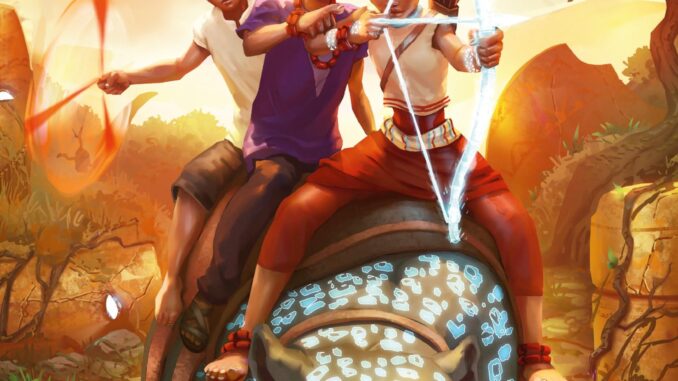
A young, black orphaned African girl with a braided afro, is pointing her armed bow at the reader. Eyes glowing with god-like power, “Iyanu: Child of Wonder” lives up to her moniker of the chosen one. Yet, although Iyanu has the power to bring her people from the brink of extinction, she is still a child. Creator and writer Roye Okupe balances a coming-of-age story with political intrigue by showing that the need for connection is necessary to maintain one’s humanity.
With no clear heir left behind for the throne of Yorubaland, a council supports Aremo to be ruler. At a council meeting Uwa wants to unite those who live outside the barriers of Elu. In hoarding resources, it has become a nation of the haves and those who live in poverty. The panels in the exchange between Uwa and an elder mimics movement. Instead of being side by side, they are positioned where the top panel shows an openness where the room is spacious and there are others in the background. The colors are neutral. By the third panel it gets increasingly claustrophobic, with the focus on the elder taking up the room as it darkens, isolating Uwa physically out of the frame. Then on the next page there is an openness again, but the tone changes from a tense confrontation to Uwa being marginalized by xenophobic tradition. Uwa sees the people who live outside the walls as part of the community, whereas political leaders consider them outsiders. When Uwa says “just because a thing does not affect you does not mean you ignore it,” instead of listening, the council further entrenches themselves in what will lead to their downfall.
At the same time the plot brewing to turn against Olori who is raising Iyanu, comes to a head. In their attempt to capture both the chosen one and Olori, Iyanu must figure out how to control her abilities and gain allies in order to fulfill her destiny. Olori is a significant character in these comics. She is the last of the Agoni. It seems that this is the spiritual center of Elu or at least an important aspect of their culture. Olori is the only one who is able to cleanse the “corrupt ones” animals who are feral. We see Olori effortlessly heal one while having a conversation with her foster child Iyanu. For such an important figure what purpose would it serve for the last preservation of Elu’s culture to be imprisoned? This is a point of contention with Iyanu she questions the origin of her abilities and where she comes from. Olori finds Iyanu several years ago alone and an amnesiac. Also, Iyanu’s powers are triggered when she is in danger. Those scenes are action packed. One set of panels in particular has Iyanu being chased by a corrupt one. She runs, flips and jumps off a waterfall. Eyes aglow even her bow becomes infused with her abilities. Still, once the danger is over Iyanu passes out. She is not able to control her powers, and her mentor Olori is captured before she can finish her training.
Throughout each volume Okupe interjects how the fictional world “Iyanu: Child of Wonder” is based on parts of Western Africa, Nigeria and Benin in particular. He uses maps of Elu and Yorubaland and explains the real history of the artwork and language. This makes this world feel real.
This ancient world shows how the monsters aren’t always animals and that community is the most important power anyone can have. Iyanu feels that her purpose is to save Olori. Those who want to control her have their own agenda and then there are those who only see her as a symbol to heal their nation of the corrupt animals and bring the land back. However, Iyanu is a child, and no one takes into account that she shouldn’t be a savior or sacrifice. Currently “Iyanu: Child of Wonder” is a cartoon, where some of the show is taken directly from several panels in the comics. This brings a new audience to the world Roye Okupe created. Still, the source material is equally as good as the adaptation. Read the volumes, see the animation. You will love them both.

Leave a Reply